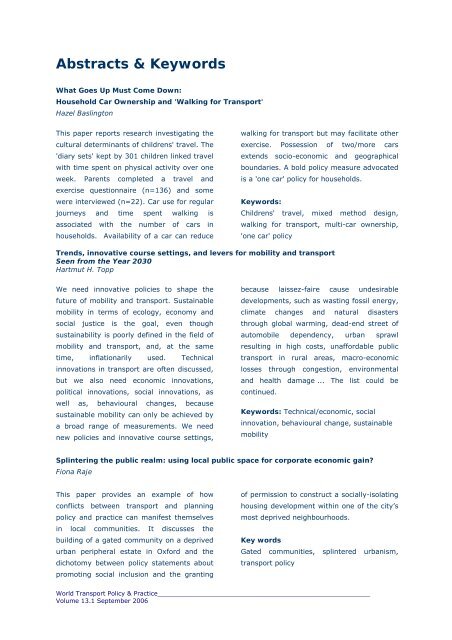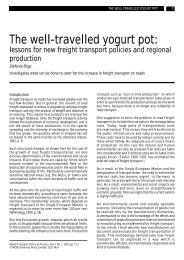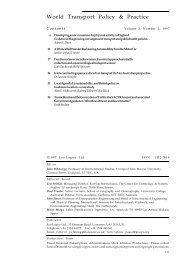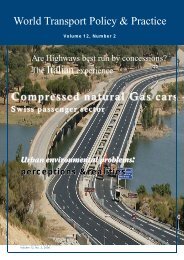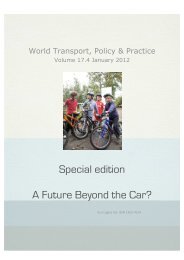Effects of pedestrianisation on the commercial and ... - Eco-Logica
Effects of pedestrianisation on the commercial and ... - Eco-Logica
Effects of pedestrianisation on the commercial and ... - Eco-Logica
Create successful ePaper yourself
Turn your PDF publications into a flip-book with our unique Google optimized e-Paper software.
Abstracts & Keywords<br />
What Goes Up Must Come Down:<br />
Household Car Ownership <strong>and</strong> 'Walking for Transport'<br />
Hazel Baslingt<strong>on</strong><br />
This paper reports research investigating <strong>the</strong><br />
cultural determinants <str<strong>on</strong>g>of</str<strong>on</strong>g> childrens' travel. The<br />
'diary sets' kept by 301 children linked travel<br />
with time spent <strong>on</strong> physical activity over <strong>on</strong>e<br />
week. Parents completed a travel <strong>and</strong><br />
exercise questi<strong>on</strong>naire (n=136) <strong>and</strong> some<br />
were interviewed (n=22). Car use for regular<br />
journeys <strong>and</strong> time spent walking is<br />
associated with <strong>the</strong> number <str<strong>on</strong>g>of</str<strong>on</strong>g> cars in<br />
households. Availability <str<strong>on</strong>g>of</str<strong>on</strong>g> a car can reduce<br />
walking for transport but may facilitate o<strong>the</strong>r<br />
exercise. Possessi<strong>on</strong> <str<strong>on</strong>g>of</str<strong>on</strong>g> two/more cars<br />
extends socio-ec<strong>on</strong>omic <strong>and</strong> geographical<br />
boundaries. A bold policy measure advocated<br />
is a '<strong>on</strong>e car' policy for households.<br />
Keywords:<br />
Childrens' travel, mixed method design,<br />
walking for transport, multi-car ownership,<br />
'<strong>on</strong>e car' policy<br />
Trends, innovative course settings, <strong>and</strong> levers for mobility <strong>and</strong> transport<br />
Seen from <strong>the</strong> Year 2030<br />
Hartmut H. Topp<br />
We need innovative policies to shape <strong>the</strong><br />
future <str<strong>on</strong>g>of</str<strong>on</strong>g> mobility <strong>and</strong> transport. Sustainable<br />
mobility in terms <str<strong>on</strong>g>of</str<strong>on</strong>g> ecology, ec<strong>on</strong>omy <strong>and</strong><br />
social justice is <strong>the</strong> goal, even though<br />
sustainability is poorly defined in <strong>the</strong> field <str<strong>on</strong>g>of</str<strong>on</strong>g><br />
mobility <strong>and</strong> transport, <strong>and</strong>, at <strong>the</strong> same<br />
time, inflati<strong>on</strong>arily used. Technical<br />
innovati<strong>on</strong>s in transport are <str<strong>on</strong>g>of</str<strong>on</strong>g>ten discussed,<br />
but we also need ec<strong>on</strong>omic innovati<strong>on</strong>s,<br />
political innovati<strong>on</strong>s, social innovati<strong>on</strong>s, as<br />
well as, behavioural changes, because<br />
sustainable mobility can <strong>on</strong>ly be achieved by<br />
a broad range <str<strong>on</strong>g>of</str<strong>on</strong>g> measurements. We need<br />
new policies <strong>and</strong> innovative course settings,<br />
because laissez-faire cause undesirable<br />
developments, such as wasting fossil energy,<br />
climate changes <strong>and</strong> natural disasters<br />
through global warming, dead-end street <str<strong>on</strong>g>of</str<strong>on</strong>g><br />
automobile dependency, urban sprawl<br />
resulting in high costs, unaffordable public<br />
transport in rural areas, macro-ec<strong>on</strong>omic<br />
losses through c<strong>on</strong>gesti<strong>on</strong>, envir<strong>on</strong>mental<br />
<strong>and</strong> health damage ... The list could be<br />
c<strong>on</strong>tinued.<br />
Keywords: Technical/ec<strong>on</strong>omic, social<br />
innovati<strong>on</strong>, behavioural change, sustainable<br />
mobility<br />
Splintering <strong>the</strong> public realm: using local public space for corporate ec<strong>on</strong>omic gain?<br />
Fi<strong>on</strong>a Raje<br />
This paper provides an example <str<strong>on</strong>g>of</str<strong>on</strong>g> how<br />
c<strong>on</strong>flicts between transport <strong>and</strong> planning<br />
policy <strong>and</strong> practice can manifest <strong>the</strong>mselves<br />
in local communities. It discusses <strong>the</strong><br />
building <str<strong>on</strong>g>of</str<strong>on</strong>g> a gated community <strong>on</strong> a deprived<br />
urban peripheral estate in Oxford <strong>and</strong> <strong>the</strong><br />
dichotomy between policy statements about<br />
promoting social inclusi<strong>on</strong> <strong>and</strong> <strong>the</strong> granting<br />
<str<strong>on</strong>g>of</str<strong>on</strong>g> permissi<strong>on</strong> to c<strong>on</strong>struct a socially-isolating<br />
housing development within <strong>on</strong>e <str<strong>on</strong>g>of</str<strong>on</strong>g> <strong>the</strong> city’s<br />
most deprived neighbourhoods.<br />
Key words<br />
Gated communities, splintered urbanism,<br />
transport policy<br />
World Transport Policy & Practice_______________________________________________________<br />
Volume 13.1 September 2006


